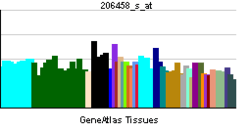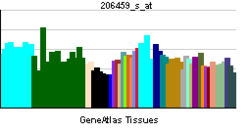WNT2B
Protein Wnt-2b is a protein that in humans is encoded by the WNT2B gene.[1][2][3]
This gene encodes a member of the wingless-type MMTV integration site (WNT) family of highly conserved, secreted signaling factors. WNT family members function in a variety of developmental processes including regulation of cell growth and differentiation and are characterized by a WNT-core domain. This gene may play a role in human development as well as human carcinogenesis.
This gene produces two alternative transcript variants.[3]
References
- ↑ Katoh M, Hirai M, Sugimura T, Terada M (Oct 1996). "Cloning, expression and chromosomal localization of Wnt-13, a novel member of the Wnt gene family". Oncogene 13 (4): 873–6. PMID 8761309.
- ↑ Katoh M, Kirikoshi H, Saitoh T, Sagara N, Koike J (Sep 2000). "Alternative splicing of the WNT-2B/WNT-13 gene". Biochem Biophys Res Commun 275 (1): 209–16. doi:10.1006/bbrc.2000.3252. PMID 10944466.
- ↑ 3.0 3.1 "Entrez Gene: WNT2B wingless-type MMTV integration site family, member 2B".
Further reading
- Katoh M (2006). "WNT2B: comparative integromics and clinical applications (Review).". Int. J. Mol. Med. 16 (6): 1103–8. doi:10.3892/ijmm.16.6.1103. PMID 16273293.
- Smolich BD, McMahon JA, McMahon AP, Papkoff J (1994). "Wnt family proteins are secreted and associated with the cell surface.". Mol. Biol. Cell 4 (12): 1267–75. doi:10.1051/jp3:1994201. PMC 275763. PMID 8167409.
- Bergstein I, Eisenberg LM, Bhalerao J et al. (1998). "Isolation of two novel WNT genes, WNT14 and WNT15, one of which (WNT15) is closely linked to WNT3 on human chromosome 17q21.". Genomics 46 (3): 450–8. doi:10.1006/geno.1997.5041. PMID 9441749.
- Katoh M (2002). "Differential regulation of WNT2 and WNT2B expression in human cancer.". Int. J. Mol. Med. 8 (6): 657–60. doi:10.3892/ijmm.8.6.657. PMID 11712082.
- Yarden RI, Brody LC (2002). "Identification of proteins that interact with BRCA1 by Far-Western library screening.". J. Cell. Biochem. 83 (4): 521–31. doi:10.1002/jcb.1257. PMID 11746496.
- Ricken A, Lochhead P, Kontogiannea M, Farookhi R (2002). "Wnt signaling in the ovary: identification and compartmentalized expression of wnt-2, wnt-2b, and frizzled-4 mRNAs.". Endocrinology 143 (7): 2741–9. doi:10.1210/en.143.7.2741. PMID 12072409.
- Ota T, Suzuki Y, Nishikawa T et al. (2004). "Complete sequencing and characterization of 21,243 full-length human cDNAs.". Nat. Genet. 36 (1): 40–5. doi:10.1038/ng1285. PMID 14702039.
- Katoh M (2005). "Molecular evolution of Wnt2b orthologs.". Int. J. Oncol. 26 (4): 1135–9. doi:10.3892/ijo.26.4.1135. PMID 15754012.
- Struewing IT, Toborek A, Mao CD (2006). "Mitochondrial and nuclear forms of Wnt13 are generated via alternative promoters, alternative RNA splicing, and alternative translation start sites.". J. Biol. Chem. 281 (11): 7282–93. doi:10.1074/jbc.M511182200. PMID 16407296.

